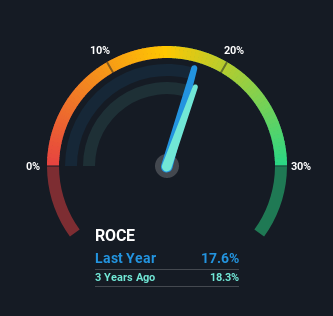- United Kingdom
- /
- Construction
- /
- LSE:MGNS
The Return Trends At Morgan Sindall Group (LON:MGNS) Look Promising

Did you know there are some financial metrics that can provide clues of a potential multi-bagger? In a perfect world, we'd like to see a company investing more capital into its business and ideally the returns earned from that capital are also increasing. Ultimately, this demonstrates that it's a business that is reinvesting profits at increasing rates of return. With that in mind, we've noticed some promising trends at Morgan Sindall Group (LON:MGNS) so let's look a bit deeper.
What is Return On Capital Employed (ROCE)?
If you haven't worked with ROCE before, it measures the 'return' (pre-tax profit) a company generates from capital employed in its business. Analysts use this formula to calculate it for Morgan Sindall Group:
Return on Capital Employed = Earnings Before Interest and Tax (EBIT) ÷ (Total Assets - Current Liabilities)
0.18 = UK£93m ÷ (UK£1.6b - UK£1.0b) (Based on the trailing twelve months to June 2021).
So, Morgan Sindall Group has an ROCE of 18%. On its own, that's a standard return, however it's much better than the 8.9% generated by the Construction industry.
See our latest analysis for Morgan Sindall Group

In the above chart we have measured Morgan Sindall Group's prior ROCE against its prior performance, but the future is arguably more important. If you'd like, you can check out the forecasts from the analysts covering Morgan Sindall Group here for free.
What Does the ROCE Trend For Morgan Sindall Group Tell Us?
We like the trends that we're seeing from Morgan Sindall Group. The numbers show that in the last five years, the returns generated on capital employed have grown considerably to 18%. The company is effectively making more money per dollar of capital used, and it's worth noting that the amount of capital has increased too, by 56%. So we're very much inspired by what we're seeing at Morgan Sindall Group thanks to its ability to profitably reinvest capital.
Another thing to note, Morgan Sindall Group has a high ratio of current liabilities to total assets of 66%. This can bring about some risks because the company is basically operating with a rather large reliance on its suppliers or other sorts of short-term creditors. Ideally we'd like to see this reduce as that would mean fewer obligations bearing risks.
The Key Takeaway
A company that is growing its returns on capital and can consistently reinvest in itself is a highly sought after trait, and that's what Morgan Sindall Group has. And a remarkable 218% total return over the last five years tells us that investors are expecting more good things to come in the future. Therefore, we think it would be worth your time to check if these trends are going to continue.
Morgan Sindall Group does have some risks though, and we've spotted 1 warning sign for Morgan Sindall Group that you might be interested in.
While Morgan Sindall Group may not currently earn the highest returns, we've compiled a list of companies that currently earn more than 25% return on equity. Check out this free list here.
New: Manage All Your Stock Portfolios in One Place
We've created the ultimate portfolio companion for stock investors, and it's free.
• Connect an unlimited number of Portfolios and see your total in one currency
• Be alerted to new Warning Signs or Risks via email or mobile
• Track the Fair Value of your stocks
Have feedback on this article? Concerned about the content? Get in touch with us directly. Alternatively, email editorial-team (at) simplywallst.com.
This article by Simply Wall St is general in nature. We provide commentary based on historical data and analyst forecasts only using an unbiased methodology and our articles are not intended to be financial advice. It does not constitute a recommendation to buy or sell any stock, and does not take account of your objectives, or your financial situation. We aim to bring you long-term focused analysis driven by fundamental data. Note that our analysis may not factor in the latest price-sensitive company announcements or qualitative material. Simply Wall St has no position in any stocks mentioned.
About LSE:MGNS
Morgan Sindall Group
Operates as a construction and regeneration company in the United Kingdom.
Outstanding track record with excellent balance sheet and pays a dividend.
Similar Companies
Market Insights
Community Narratives




